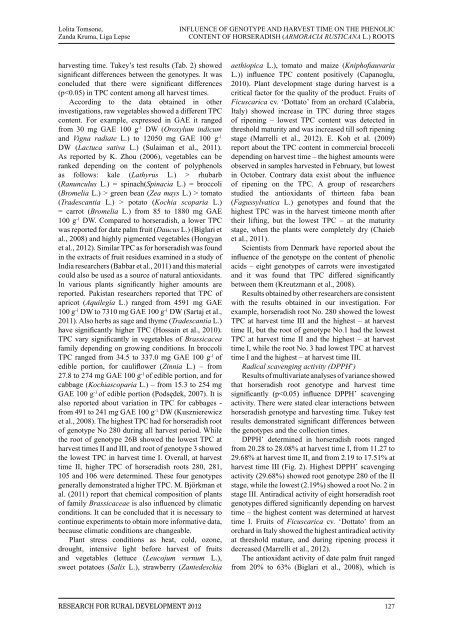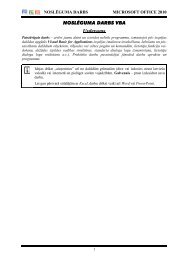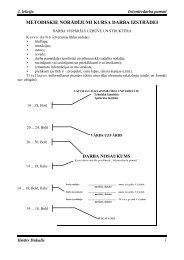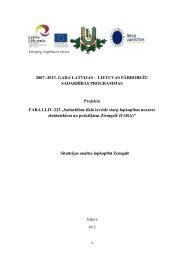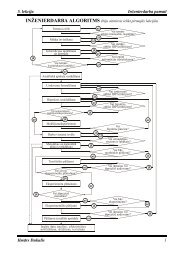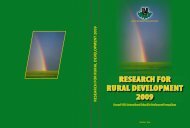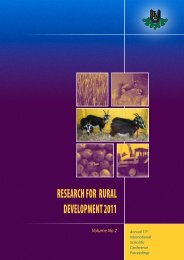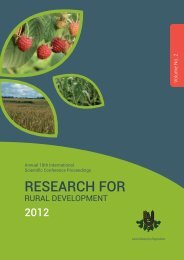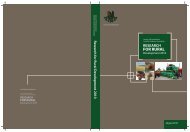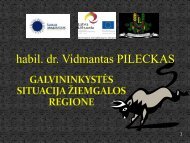LATVIA UNIVERSITY OF AGRICULTURE - Latvijas ...
LATVIA UNIVERSITY OF AGRICULTURE - Latvijas ...
LATVIA UNIVERSITY OF AGRICULTURE - Latvijas ...
- No tags were found...
Create successful ePaper yourself
Turn your PDF publications into a flip-book with our unique Google optimized e-Paper software.
Lolita Tomsone,Zanda Kruma, Liga LepseINFLUENCE <strong>OF</strong> GENOTYPE AND HARVEST TIME ON THE PHENOLICCONTENT <strong>OF</strong> HORSERADISH (ARMORACIA RUSTICANA L.) ROOTSharvesting time. Tukey’s test results (Tab. 2) showedsignificant differences between the genotypes. It wasconcluded that there were significant differences(p rhubarb(Ranunculus L.) = spinach(Spinacia L.) = broccoli(Bromelia L.) > green bean (Zea mays L.) > tomato(Tradescantia L.) > potato (Kochia scoparia L.)= carrot (Bromelia L.) from 85 to 1880 mg GAE100 g -1 DW. Compared to horseradish, a lower TPCwas reported for date palm fruit (Daucus L.) (Biglari etal., 2008) and highly pigmented vegetables (Hongyanet al., 2012). Similar TPC as for horseradish was foundin the extracts of fruit residues examined in a study ofIndia researchers (Babbar et al., 2011) and this materialcould also be used as a source of natural antioxidants.In various plants significantly higher amounts arereported. Pakistan researchers reported that TPC ofapricot (Aquilegia L.) ranged from 4591 mg GAE100 g -1 DW to 7310 mg GAE 100 g -1 DW (Sartaj et al.,2011). Also herbs as sage and thyme (Tradescantia L.)have significantly higher TPC (Hossain et al., 2010).TPC vary significantly in vegetables of Brassicaceafamily depending on growing conditions. In broccoliTPC ranged from 34.5 to 337.0 mg GAE 100 g -1 ofedible portion, for cauliflower (Zinnia L.) – from27.8 to 274 mg GAE 100 g -1 of edible portion, and forcabbage (Kochiascoparia L.) – from 15.3 to 254 mgGAE 100 g -1 of edible portion (Podsędek, 2007). It isalso reported about variation in TPC for cabbages -from 491 to 241 mg GAE 100 g -1 DW (Kusznierewiczet al., 2008). The highest TPC had for horseradish rootof genotype No 280 during all harvest period. Whilethe root of genotype 26B showed the lowest TPC atharvest times II and III, and root of genotype 3 showedthe lowest TPC in harvest time I. Overall, at harvesttime II, higher TPC of horseradish roots 280, 281,105 and 106 were determined. These four genotypesgenerally demonstrated a higher TPC. M. Björkman etal. (2011) report that chemical composition of plantsof family Brassicaceae is also influenced by climaticconditions. It can be concluded that it is necessary tocontinue experiments to obtain more informative data,because climatic conditions are changeable.Plant stress conditions as heat, cold, ozone,drought, intensive light before harvest of fruitsand vegetables (lettuce (Leucojum vernum L.),sweet potatoes (Salix L.), strawberry (Zantedeschiaaethiopica L.), tomato and maize (KniphofiauvariaL.)) influence TPC content positively (Capanoglu,2010). Plant development stage during harvest is acritical factor for the quality of the product. Fruits ofFicuscarica cv. ‘Dottato’ from an orchard (Calabria,Italy) showed increase in TPC during three stagesof ripening – lowest TPC content was detected inthreshold maturity and was increased till soft ripeningstage (Marrelli et al., 2012). E. Koh et al. (2009)report about the TPC content in commercial broccolidepending on harvest time – the highest amounts wereobserved in samples harvested in February, but lowestin October. Contrary data exist about the influenceof ripening on the TPC. A group of researchersstudied the antioxidants of thirteen faba bean(Fagussylvatica L.) genotypes and found that thehighest TPC was in the harvest timeone month aftertheir lifting, but the lowest TPC – at the maturitystage, when the plants were completely dry (Chaiebet al., 2011).Scientists from Denmark have reported about theinfluence of the genotype on the content of phenolicacids – eight genotypes of carrots were investigatedand it was found that TPC differed significantlybetween them (Kreutzmann et al., 2008).Results obtained by other researchers are consistentwith the results obtained in our investigation. Forexample, horseradish root No. 280 showed the lowestTPC at harvest time III and the highest – at harvesttime II, but the root of genotype No.1 had the lowestTPC at harvest time II and the highest – at harvesttime I, while the root No. 3 had lowest TPC at harvesttime I and the highest – at harvest time III.Radical scavenging activity (DPPH˙)Results of multivariate analyses of variance showedthat horseradish root genotype and harvest timesignificantly (p


